

Apantomancy. Apantomancy is a form of divination using articles at hand or things that present themselves by chance.[1] The diviner works him/herself into a state of trance until an object or event is perceived and a divination worked out.

This form of divination was used in ancient Rome by the augurs.[2] There is no set of standard interpretations in apantomancy, with the interpretations of events depending on the background of the seer.[2] A branch of apantomancy places special significance on chance meetings of animals.[3][2] The superstition regarding black cats crossing your path comes from this form of divination.[1] Other common superstitions based on apantomancy are the belief that seeing a buzzard is an omen of death.[4] Rat (zodiac) Alan Leo. Alan Leo Alan Leo, born William Frederick Allan, (Westminster, 7 August 1860 - Bude, 30 August 1917), was a prominent British astrologer, author, publisher and theosophist.
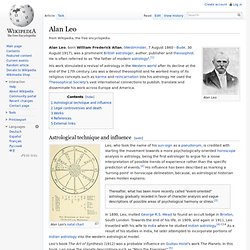
Exaltation (astrology) Astrological compatibility. Astrological compatibility (synastry) is the branch of astrology that studies relationships by comparing natal horoscopes.
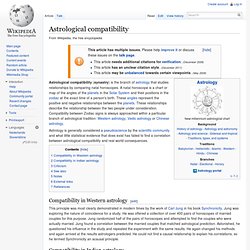
A natal horoscope is a chart or map of the angles of the planets in the Solar System and their positions in the zodiac at the exact time of a person's birth. These angles represent the positive and negative relationships between the planets. These relationships describe the relationship between the two people under consideration. Compatibility between Zodiac signs is always approached within a particular branch of astrological tradition: Western astrology, Vedic astrology or Chinese astrology. Astrology is generally considered a pseudoscience by the scientific community and what little statistical evidence that does exist has failed to find a correlation between astrological compatibility and real world consequences. Sidereal and tropical astrology. Sidereal and tropical are astrological terms used to describe two different definitions of a "year".

They are also used as terms for two systems of ecliptic coordinates used in astrology. Planets in astrology. Planets in astrology have a meaning different from the modern astronomical understanding of what a planet is.
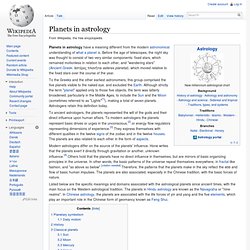
Before the age of telescopes, the night sky was thought to consist of two very similar components: fixed stars, which remained motionless in relation to each other, and "wandering stars" (Ancient Greek: ἀστέρες πλανῆται asteres planetai), which moved relative to the fixed stars over the course of the year. To the Greeks and the other earliest astronomers, this group comprised the five planets visible to the naked eye, and excluded the Earth.
Although strictly the term "planet" applied only to those five objects, the term was latterly broadened, particularly in the Middle Ages, to include the Sun and the Moon (sometimes referred to as "Lights"[1]), making a total of seven planets. Astrologers retain this definition today. Determinism. Determinism is the philosophical position that for every event, including human action, there exist conditions that could cause no other event.

"There are many determinisms, depending upon what pre-conditions are considered to be determinative of an event. "[1] Deterministic theories throughout the history of philosophy have sprung from diverse and sometimes overlapping motives and considerations. Planetary hours. Each planetary day begins at sunrise, and ends at the next day's sunrise.
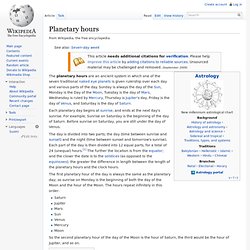
Hellenistic astrology. Hellenistic astrology is a tradition of horoscopic astrology that was developed and practiced in the late Hellenistic period in and around the Mediterranean region, especially in Egypt.
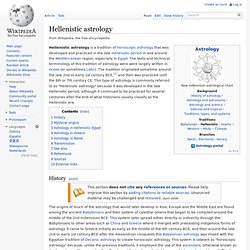
The texts and technical terminology of this tradition of astrology were were largely written in Greek (or sometimes Latin). The tradition originated sometime around the late 2nd or early 1st century BCE,[1] and then was practiced until the 6th or 7th century CE. This type of astrology is commonly referred to as "Hellenistic astrology" because it was developed in the late Hellenistic period, although it continued to be practiced for several centuries after the end of what historians usually classify as the Hellenistic era.
History[edit] Mythical origins[edit] Several Hellenistic astrologers ascribe its creation to a mythical sage named Hermes Trismegistus. Astrology in Hellenistic Egypt[edit] After the occupation by Alexander the Great in 332 BCE, Egypt came under Greek rule and influence. Sidereal and tropical astrology. Thema Mundi. Burmese zodiac. The Burmese zodiac (Burmese: ဇာတာ ရာသီခွင်, [zàdà jàðì gwɪ̀ɴ]) is the traditional Burmese system of astronomy and astrology.

While it is still an important component of the Burmese calendar, today, the zodiac is closely identified with Burmese astrology, called Bedin (ဗေဒင်). Largely derived from Hindu astronomy and Vedic astrology, the Burmese zodiac consists of not only the same 12 signs of the Western zodiac but also 27 lunar mansions of the month and eight weekday signs. Structure[edit source | editbeta] Seasons[edit source | editbeta] The Burmese zodiac, like the Western zodiac, is divided into 12 signs called yathi (ရာသီ, [jàðì]).
Lunar mansions[edit source | editbeta] Astrology and the classical elements. Western astrology[edit] Four Classical Elements; this classic diagram has two squares on top of each other, with the corners of one being the classical elements, and the corners of the other being the properties In Western tropical astrology, there are always 12 astrological signs; thus, each of the four elements is associated with 3 signs of the Zodiac which are always located exactly 120 degrees away from each other along the ecliptic and said to be in trine with one another.
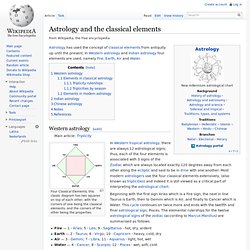
Most modern astrologers use the four classical elements extensively, (also known as triplicities) and indeed it is still viewed as a critical part of interpreting the astrological chart. Beginning with the first sign Aries which is a Fire sign, the next in line Taurus is Earth, then to Gemini which is Air, and finally to Cancer which is Water. This cycle continues on twice more and ends with the twelfth and final astrological sign, Pisces. Cardinal sign (astrology) This article is about the zodiac signs. For the five cardinal signs of inflammation, see Inflammation#Clinical_signs. The four cardinal signs are: Jump up ^ Guido Bonatti, Liber Astronomiae, Part II.
[tr. Robert Zoller]. Nostradamus. Michel de Nostredame (depending on the source, 14 or 21 December 1503[1] – 2 July 1566), usually Latinised as Nostradamus,[2] was a French apothecary and reputed seer who published collections of prophecies that have since become widely famous. He is best known for his book Les Propheties, the first edition of which appeared in 1555. Since the publication of this book, which has rarely been out of print since his death, Nostradamus has attracted a following that, along with much of the popular press, credits him with predicting many major world events.
Most academic sources maintain that the associations made between world events and Nostradamus's quatrains are largely the result of misinterpretations or mistranslations (sometimes deliberate) or else are so tenuous as to render them useless as evidence of any genuine predictive power. Biography Childhood Student years Marriage and healing work Seer Century I, Quatrain 1: 1555 Lyon Bonhomme edition. Astrological symbols. Timeline of the far future.
Medical astrology.